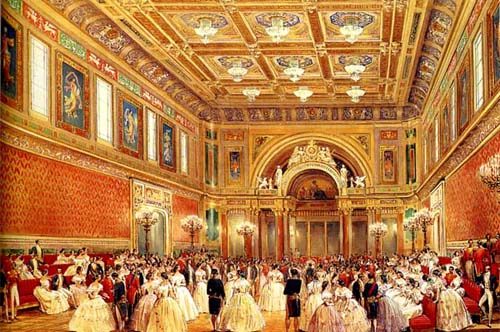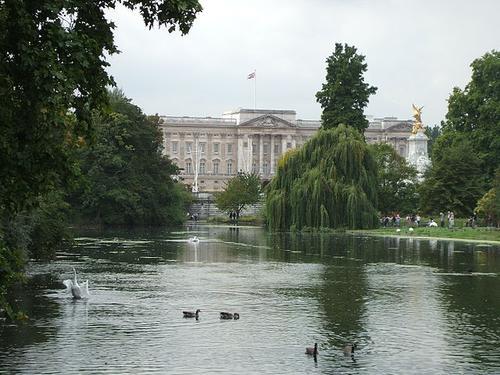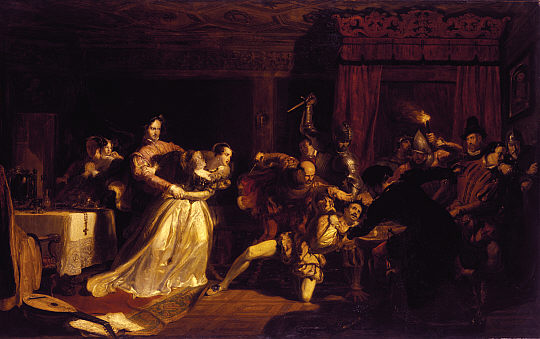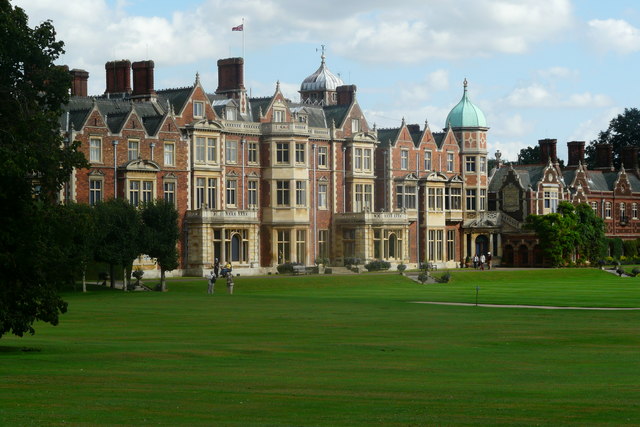It’s Queen Elizabeth II’s diamond jubilee this year, and the Cambridge’s first wedding anniversary, and everyone has Royalmania. Good enough excuse to have a look at a few of the places the royals live. With a few ghosts thrown in, for interest.

Buckingham Palace, Windsor and Holyrood are the queen’s three official residences, so let’s start with those.



The rear terrace of BP is said to be haunted by the ghost of a brown-cowled, enchained monk. The palace was built on the grounds of a long-ago priory, and the monk reputedly died in one of its punishment cells.
Another reputed ghost is that of Major John Gwynne, a private secretary to King Edward VII. Fearing disgrace in an upcoming divorce case, he shot himself in his office on the first floor.



When still young princeses, Elizabeth II and her sister Margaret reported seeing the ghost of Elizabeth I here.
Ghost count overall: at least 4, possibly as many as 25. Henry VIII, Elizabeth 1, George III and Hern the Hunter. George III was confined to a single room here during his periods of madness, and has been seen gazing sadly out of the window of that room, beneath the library.
Ghost count for the cloister: 1. Henry VIII, heard clomping along on his ulcerated leg, which eventually killed him.
Ghost count for the forest and Great Park: 1. Windsor Castle isn’t far from London, and it is reported that the Queen will allow campers to set up their tents, trailers and RVs on the (vast) (5,000 acres) grounds. 286 sites will be available, and will house up to 1,000 people. Catering will be available, selling food from the royal farms.
Campers should try not to see the ghost of Herne the Hunter, since he is an omen of ill-fortune. Herne was a huntsman for Richard II. Or a poacher caught on the grounds during Henry VIII’s time. Legends vary.



Holyrood has been a royal residence since about 1369. It is infamous for having been the scene, in 1566, of the murder of David Rizzio, possibly Mary, Queen of Scot’s lover. Her husband, Lord Darnley, instigated the murder, which happened in Mary’s dining room, with Mary present, 7 months pregnant. It is said that bloodstains of the floor reappear, no matter how thoroughly they are scrubbed out.
Darnley himself came to a well-deserved bad end, apparently murdered after fleeing an explosion in his Edinburgh house. His ghost has been reported hiding in the shadows of his old rooms at Holyrood.
Holyrood has a naked ghost, Bald Agnes, who appears in the garden. She was executed as a witch in 1592.


The royal family usually spends several weeks over Christmas at Sandringham. Ghostly events include sudden washes of cold air, experienced by Prince Charles during the 1980s. There is a clock whose hands move independent of its mechanism. And books flying off library shelves. Poltergeists are very active, throwing Christmas cards around and pulling blankets off beds. There are footsteps heard when no walker is present, ghastly wheezing sounds, and light switches turning on and off by themselves.

Elizabeth I, and others, are said to have seen the kilt-wearing ghost of John Brown, Queen Victoria’s great friend, walking the halls.


Many lesser royals have had apartments in Kensington, including Princesses Margaret and Diana. Currently the Cambridges live there, and Prince Harry. The palace was renovated, to the tune of $19,000,000, during 2011.
The palace is haunted by the ghost of Princess Sophie, 5th daughter of George III. She fell in love with an unsuitable man, and for solace took to her spinning wheel, whose whirr can be heard today, if you listen carefully. Other versions of the story give the spinning lady as being an aunt of Queen Victoria.
Other Kensington ghosts are a man wearing white breeches, seen walking the courtyards. And the ghost of King George II, on the roof, staring at the weather vane.

St. James Palace is now a ceremonial and administrative centre – no king or queen has lived here in 200 years. It was built by Henry VIII on the site of a former leper hospital.
It’s ghost is the valet of the Duke of Cumberland, suspected of carrying on an affair with both the valet’s wife and his daughter. In 1810 the valet was found dead, apparently murdered. But since the Duke was suspected of having killed him, it was ruled a suicide.
Even without ghosts, the palace has its oogy aspects. The heart and bowels of Mary I, Henry VIII’s daughter, are buried here. Charles I slept here – but probably not much – the night before his execution.


Hampton Court Palace is so haunted, it even has an entire Haunted Gallery. Catherine Howard, 5th wife of Henry VIII (him again!) was held in house-arrest there before her beheading, on Tower Hill, for adultery in 1542. Visitors to the gallery have reported hearing screams – Catherine, running unsuccessfully for her life – and having general feelings of creepiness.
Jane Seymour was Henry VIII’s third wife, after Anne Boleyn, and the only wife to bear him a son, Edward VI, although she died soon after from complications. She has reportedly been seen in a white robe, walking through Clock Court on his birthday, holding a candle.
Henry himself, and Mrs. Sybil Penn, Edward VI’s nurse, have also been seen.




The Tower is probably one of the most haunted places in Britain, which is hardly surprising, considering it has a been a place of imprisonment, trial, torture and execution for hundreds of years. This is where Anne Boleyn is said to walk, holding her severed head under her arm. In 1816 a sentry reported seeing the ghost of a bear outside the Jewel House.
Henry VI and Lady Jane Grey have also been seen here, and Margaret Pole, Countess of Salisbury, executed for treason in 1541 (she supported Henry VIII’s Catholic wife Katherine of Aragorn while Henry was trying to divorce her).
Perhaps the saddest ghosts of Tower Hill are Edward V and his younger brother Richard, Duke of York. Edward VI was 12 years old and only recently king, upon the death of his father Edward IV, in April of 1483. However, there was much doubt as to their legitimacy. In June of 1483 Parliament declared them illegitimate and they were taken to the Tower. Their uncle (Richard III) was crowned king on 6 July 1483. (Richard lived only two years, then the crown went to Henry VII.)
The two young princes were never seen again. No funeral was ever recorded. Rumours and legends as to their fate abound. Did they escape? Two pretenders came forward, but never proved their cases. The bones of two suitably-aged boys were discovered under a staircase in the White Tower in 1674 and interred in Westminster Abbey on orders of Charles II, but no scientific tests have ever been carried out on them.
The princes’ most likely fate seems to have been being smothered with a pillow by… their uncle? Richard’s henchman Sir James Tyrell? Tyrell’s own henchmen, Miles Forrest and John Dighton? Henry VII himself? No one really knows.
Their ghosts are seen in the Bloody Tower, where they were being held at the time of their disappearance.
All images: Wiki Commons